Social Organization: Elements, Interpretation, Development, and Construction in Yanomamo Community
VerifiedAdded on 2023/01/17
|12
|3237
|92
AI Summary
This paper explores the concept of social organization, including its elements, interpretation, development, and construction in the Yanomamo community. It discusses the patterns of marriage, kinship terminology, and intergroup relations within the community.
Contribute Materials
Your contribution can guide someone’s learning journey. Share your
documents today.
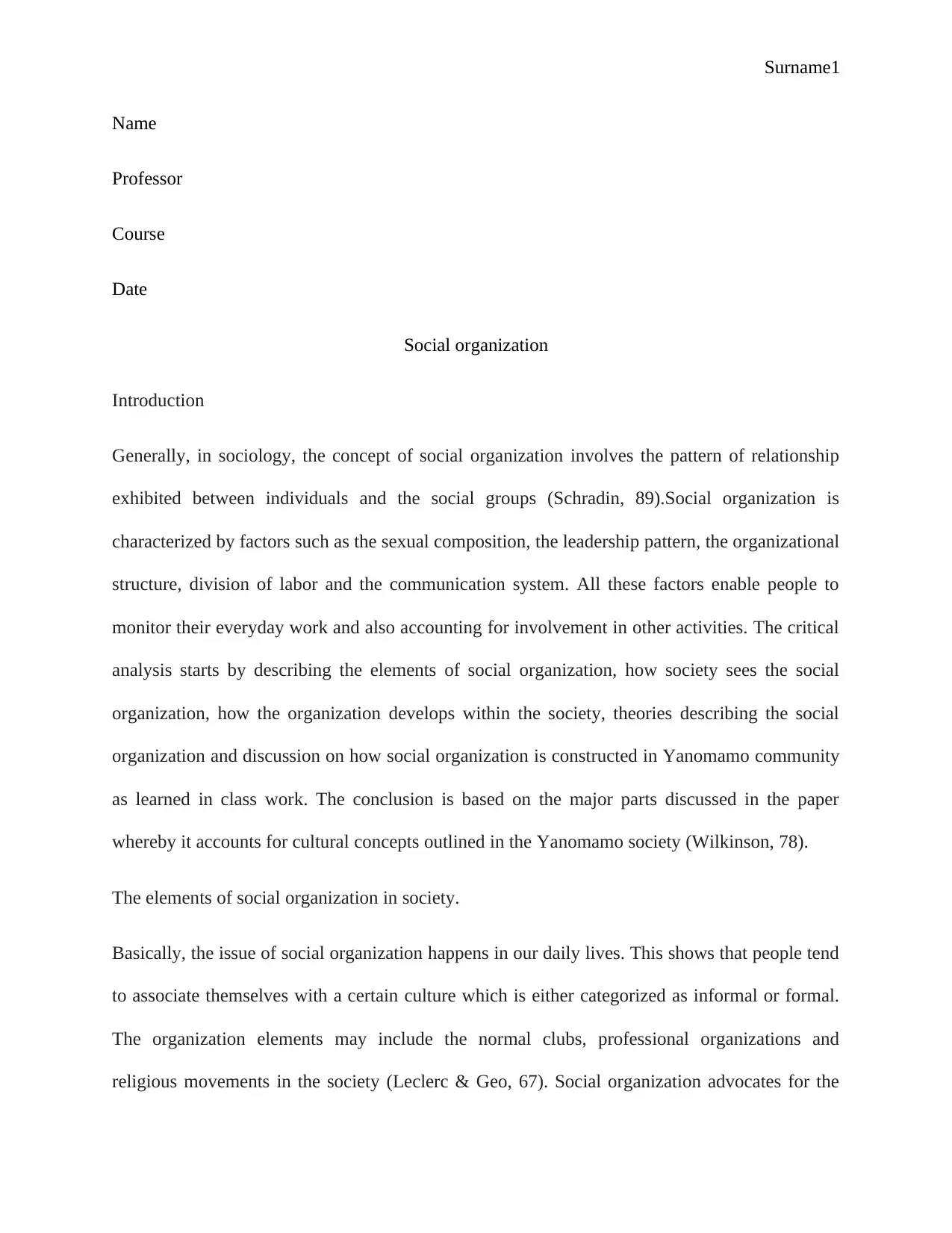
Surname1
Name
Professor
Course
Date
Social organization
Introduction
Generally, in sociology, the concept of social organization involves the pattern of relationship
exhibited between individuals and the social groups (Schradin, 89).Social organization is
characterized by factors such as the sexual composition, the leadership pattern, the organizational
structure, division of labor and the communication system. All these factors enable people to
monitor their everyday work and also accounting for involvement in other activities. The critical
analysis starts by describing the elements of social organization, how society sees the social
organization, how the organization develops within the society, theories describing the social
organization and discussion on how social organization is constructed in Yanomamo community
as learned in class work. The conclusion is based on the major parts discussed in the paper
whereby it accounts for cultural concepts outlined in the Yanomamo society (Wilkinson, 78).
The elements of social organization in society.
Basically, the issue of social organization happens in our daily lives. This shows that people tend
to associate themselves with a certain culture which is either categorized as informal or formal.
The organization elements may include the normal clubs, professional organizations and
religious movements in the society (Leclerc & Geo, 67). Social organization advocates for the
Name
Professor
Course
Date
Social organization
Introduction
Generally, in sociology, the concept of social organization involves the pattern of relationship
exhibited between individuals and the social groups (Schradin, 89).Social organization is
characterized by factors such as the sexual composition, the leadership pattern, the organizational
structure, division of labor and the communication system. All these factors enable people to
monitor their everyday work and also accounting for involvement in other activities. The critical
analysis starts by describing the elements of social organization, how society sees the social
organization, how the organization develops within the society, theories describing the social
organization and discussion on how social organization is constructed in Yanomamo community
as learned in class work. The conclusion is based on the major parts discussed in the paper
whereby it accounts for cultural concepts outlined in the Yanomamo society (Wilkinson, 78).
The elements of social organization in society.
Basically, the issue of social organization happens in our daily lives. This shows that people tend
to associate themselves with a certain culture which is either categorized as informal or formal.
The organization elements may include the normal clubs, professional organizations and
religious movements in the society (Leclerc & Geo, 67). Social organization advocates for the
Secure Best Marks with AI Grader
Need help grading? Try our AI Grader for instant feedback on your assignments.
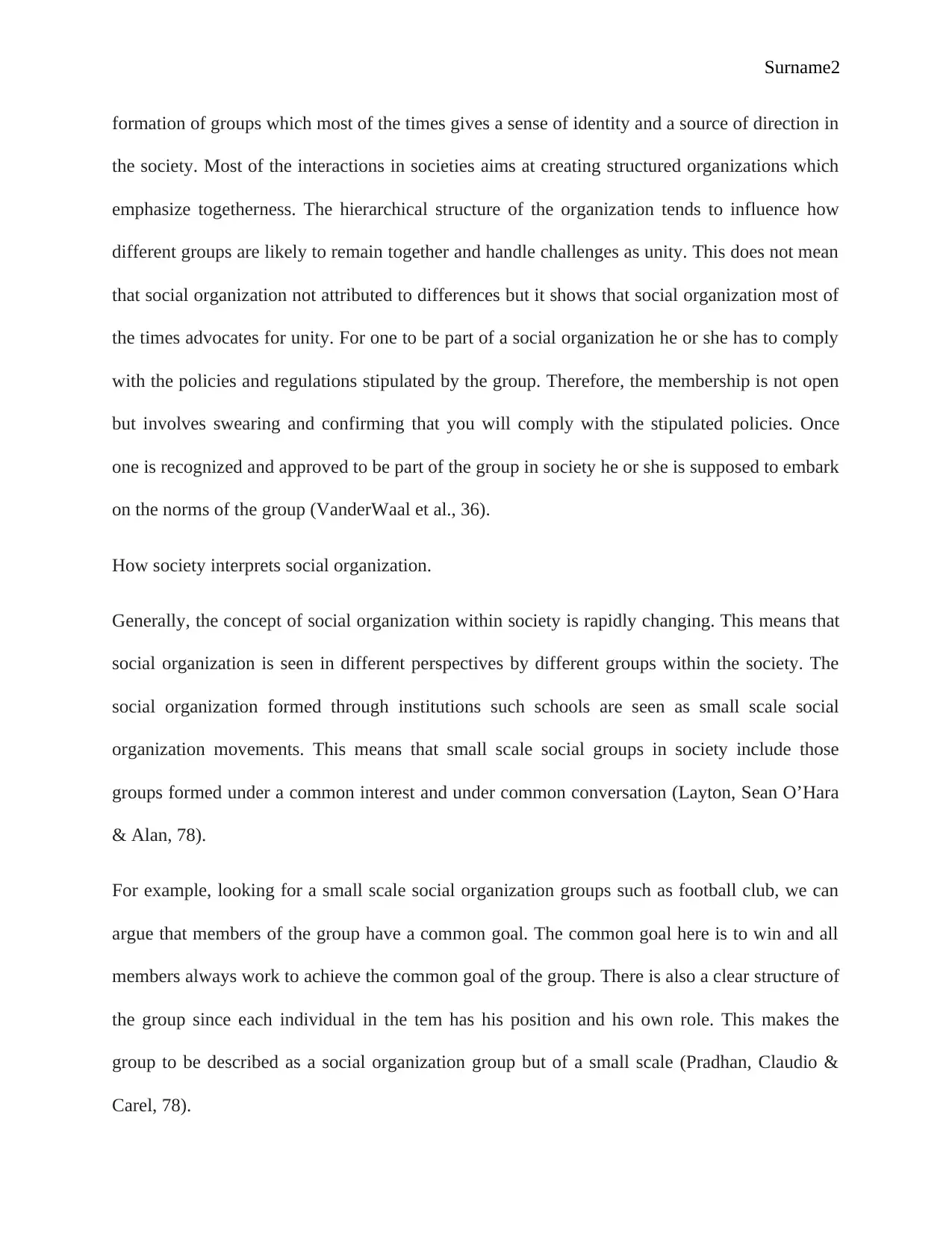
Surname2
formation of groups which most of the times gives a sense of identity and a source of direction in
the society. Most of the interactions in societies aims at creating structured organizations which
emphasize togetherness. The hierarchical structure of the organization tends to influence how
different groups are likely to remain together and handle challenges as unity. This does not mean
that social organization not attributed to differences but it shows that social organization most of
the times advocates for unity. For one to be part of a social organization he or she has to comply
with the policies and regulations stipulated by the group. Therefore, the membership is not open
but involves swearing and confirming that you will comply with the stipulated policies. Once
one is recognized and approved to be part of the group in society he or she is supposed to embark
on the norms of the group (VanderWaal et al., 36).
How society interprets social organization.
Generally, the concept of social organization within society is rapidly changing. This means that
social organization is seen in different perspectives by different groups within the society. The
social organization formed through institutions such schools are seen as small scale social
organization movements. This means that small scale social groups in society include those
groups formed under a common interest and under common conversation (Layton, Sean O’Hara
& Alan, 78).
For example, looking for a small scale social organization groups such as football club, we can
argue that members of the group have a common goal. The common goal here is to win and all
members always work to achieve the common goal of the group. There is also a clear structure of
the group since each individual in the tem has his position and his own role. This makes the
group to be described as a social organization group but of a small scale (Pradhan, Claudio &
Carel, 78).
formation of groups which most of the times gives a sense of identity and a source of direction in
the society. Most of the interactions in societies aims at creating structured organizations which
emphasize togetherness. The hierarchical structure of the organization tends to influence how
different groups are likely to remain together and handle challenges as unity. This does not mean
that social organization not attributed to differences but it shows that social organization most of
the times advocates for unity. For one to be part of a social organization he or she has to comply
with the policies and regulations stipulated by the group. Therefore, the membership is not open
but involves swearing and confirming that you will comply with the stipulated policies. Once
one is recognized and approved to be part of the group in society he or she is supposed to embark
on the norms of the group (VanderWaal et al., 36).
How society interprets social organization.
Generally, the concept of social organization within society is rapidly changing. This means that
social organization is seen in different perspectives by different groups within the society. The
social organization formed through institutions such schools are seen as small scale social
organization movements. This means that small scale social groups in society include those
groups formed under a common interest and under common conversation (Layton, Sean O’Hara
& Alan, 78).
For example, looking for a small scale social organization groups such as football club, we can
argue that members of the group have a common goal. The common goal here is to win and all
members always work to achieve the common goal of the group. There is also a clear structure of
the group since each individual in the tem has his position and his own role. This makes the
group to be described as a social organization group but of a small scale (Pradhan, Claudio &
Carel, 78).
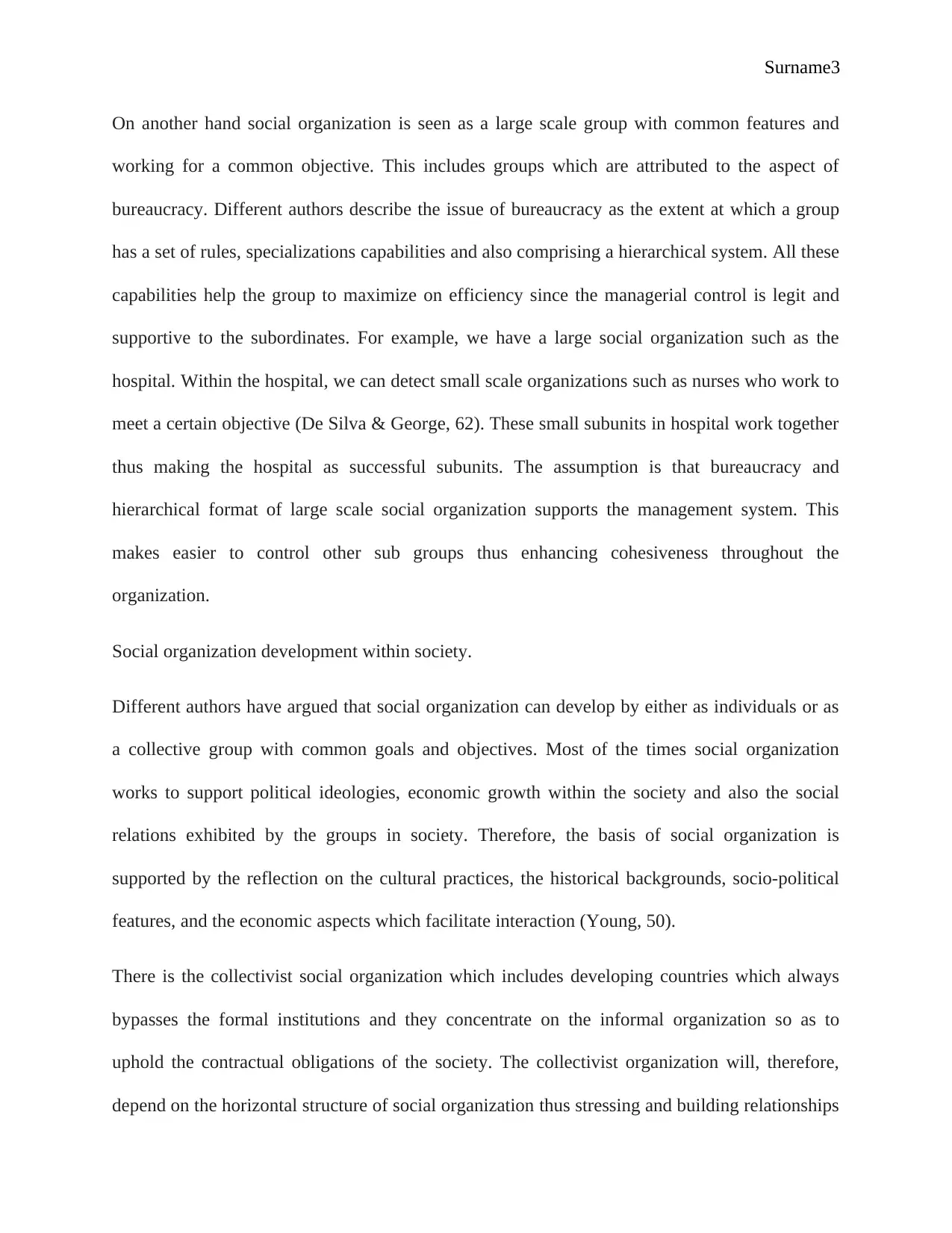
Surname3
On another hand social organization is seen as a large scale group with common features and
working for a common objective. This includes groups which are attributed to the aspect of
bureaucracy. Different authors describe the issue of bureaucracy as the extent at which a group
has a set of rules, specializations capabilities and also comprising a hierarchical system. All these
capabilities help the group to maximize on efficiency since the managerial control is legit and
supportive to the subordinates. For example, we have a large social organization such as the
hospital. Within the hospital, we can detect small scale organizations such as nurses who work to
meet a certain objective (De Silva & George, 62). These small subunits in hospital work together
thus making the hospital as successful subunits. The assumption is that bureaucracy and
hierarchical format of large scale social organization supports the management system. This
makes easier to control other sub groups thus enhancing cohesiveness throughout the
organization.
Social organization development within society.
Different authors have argued that social organization can develop by either as individuals or as
a collective group with common goals and objectives. Most of the times social organization
works to support political ideologies, economic growth within the society and also the social
relations exhibited by the groups in society. Therefore, the basis of social organization is
supported by the reflection on the cultural practices, the historical backgrounds, socio-political
features, and the economic aspects which facilitate interaction (Young, 50).
There is the collectivist social organization which includes developing countries which always
bypasses the formal institutions and they concentrate on the informal organization so as to
uphold the contractual obligations of the society. The collectivist organization will, therefore,
depend on the horizontal structure of social organization thus stressing and building relationships
On another hand social organization is seen as a large scale group with common features and
working for a common objective. This includes groups which are attributed to the aspect of
bureaucracy. Different authors describe the issue of bureaucracy as the extent at which a group
has a set of rules, specializations capabilities and also comprising a hierarchical system. All these
capabilities help the group to maximize on efficiency since the managerial control is legit and
supportive to the subordinates. For example, we have a large social organization such as the
hospital. Within the hospital, we can detect small scale organizations such as nurses who work to
meet a certain objective (De Silva & George, 62). These small subunits in hospital work together
thus making the hospital as successful subunits. The assumption is that bureaucracy and
hierarchical format of large scale social organization supports the management system. This
makes easier to control other sub groups thus enhancing cohesiveness throughout the
organization.
Social organization development within society.
Different authors have argued that social organization can develop by either as individuals or as
a collective group with common goals and objectives. Most of the times social organization
works to support political ideologies, economic growth within the society and also the social
relations exhibited by the groups in society. Therefore, the basis of social organization is
supported by the reflection on the cultural practices, the historical backgrounds, socio-political
features, and the economic aspects which facilitate interaction (Young, 50).
There is the collectivist social organization which includes developing countries which always
bypasses the formal institutions and they concentrate on the informal organization so as to
uphold the contractual obligations of the society. The collectivist organization will, therefore,
depend on the horizontal structure of social organization thus stressing and building relationships
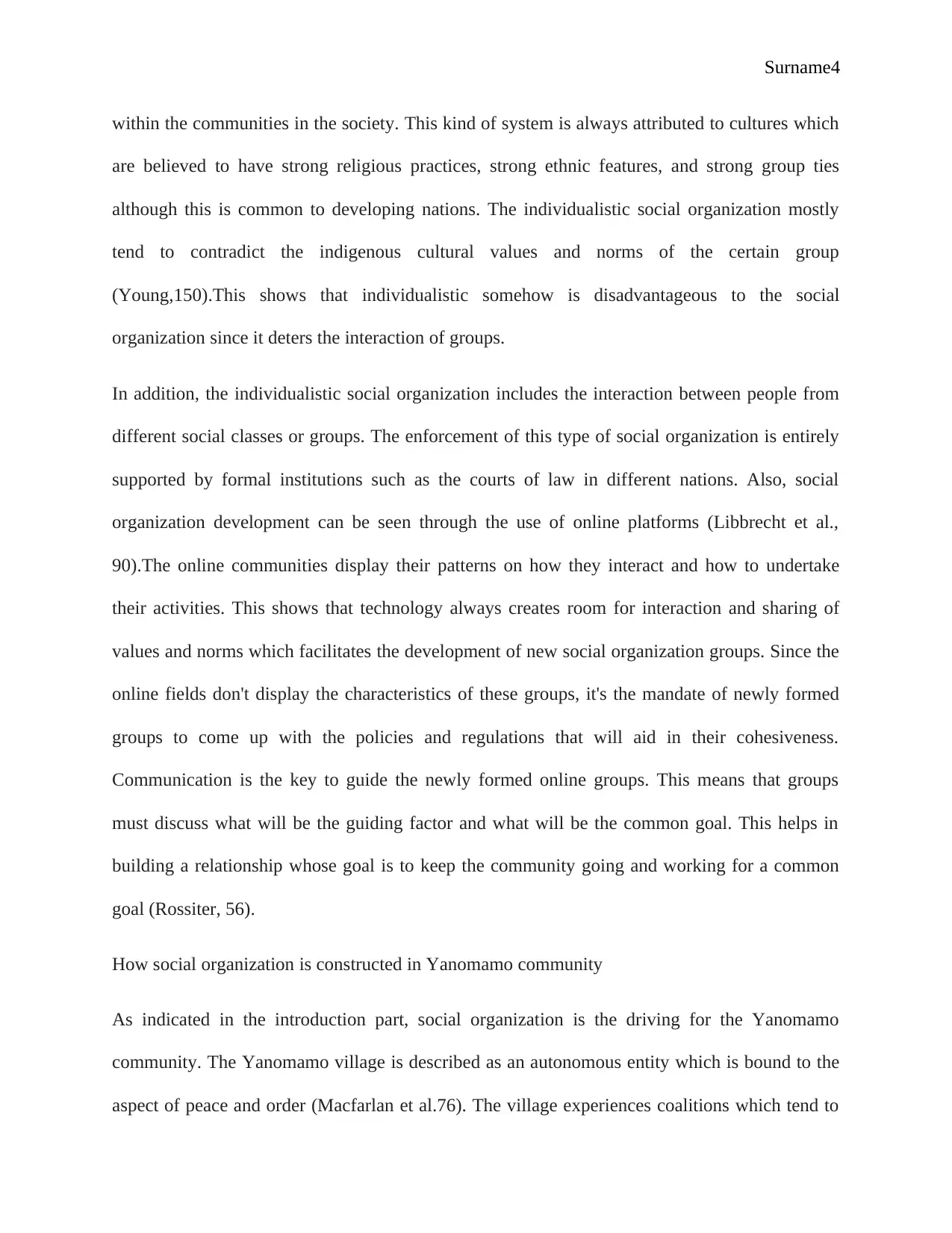
Surname4
within the communities in the society. This kind of system is always attributed to cultures which
are believed to have strong religious practices, strong ethnic features, and strong group ties
although this is common to developing nations. The individualistic social organization mostly
tend to contradict the indigenous cultural values and norms of the certain group
(Young,150).This shows that individualistic somehow is disadvantageous to the social
organization since it deters the interaction of groups.
In addition, the individualistic social organization includes the interaction between people from
different social classes or groups. The enforcement of this type of social organization is entirely
supported by formal institutions such as the courts of law in different nations. Also, social
organization development can be seen through the use of online platforms (Libbrecht et al.,
90).The online communities display their patterns on how they interact and how to undertake
their activities. This shows that technology always creates room for interaction and sharing of
values and norms which facilitates the development of new social organization groups. Since the
online fields don't display the characteristics of these groups, it's the mandate of newly formed
groups to come up with the policies and regulations that will aid in their cohesiveness.
Communication is the key to guide the newly formed online groups. This means that groups
must discuss what will be the guiding factor and what will be the common goal. This helps in
building a relationship whose goal is to keep the community going and working for a common
goal (Rossiter, 56).
How social organization is constructed in Yanomamo community
As indicated in the introduction part, social organization is the driving for the Yanomamo
community. The Yanomamo village is described as an autonomous entity which is bound to the
aspect of peace and order (Macfarlan et al.76). The village experiences coalitions which tend to
within the communities in the society. This kind of system is always attributed to cultures which
are believed to have strong religious practices, strong ethnic features, and strong group ties
although this is common to developing nations. The individualistic social organization mostly
tend to contradict the indigenous cultural values and norms of the certain group
(Young,150).This shows that individualistic somehow is disadvantageous to the social
organization since it deters the interaction of groups.
In addition, the individualistic social organization includes the interaction between people from
different social classes or groups. The enforcement of this type of social organization is entirely
supported by formal institutions such as the courts of law in different nations. Also, social
organization development can be seen through the use of online platforms (Libbrecht et al.,
90).The online communities display their patterns on how they interact and how to undertake
their activities. This shows that technology always creates room for interaction and sharing of
values and norms which facilitates the development of new social organization groups. Since the
online fields don't display the characteristics of these groups, it's the mandate of newly formed
groups to come up with the policies and regulations that will aid in their cohesiveness.
Communication is the key to guide the newly formed online groups. This means that groups
must discuss what will be the guiding factor and what will be the common goal. This helps in
building a relationship whose goal is to keep the community going and working for a common
goal (Rossiter, 56).
How social organization is constructed in Yanomamo community
As indicated in the introduction part, social organization is the driving for the Yanomamo
community. The Yanomamo village is described as an autonomous entity which is bound to the
aspect of peace and order (Macfarlan et al.76). The village experiences coalitions which tend to
Secure Best Marks with AI Grader
Need help grading? Try our AI Grader for instant feedback on your assignments.
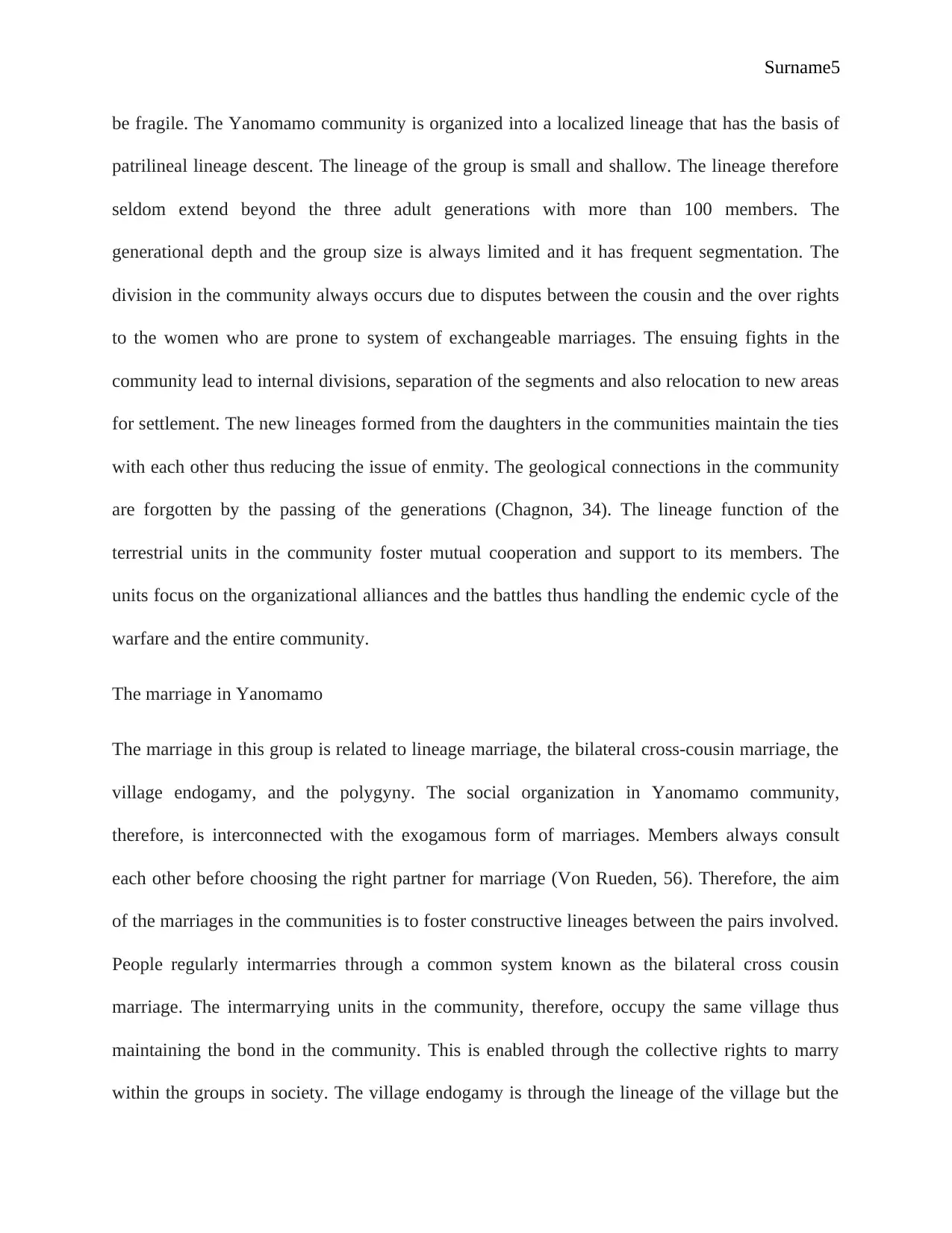
Surname5
be fragile. The Yanomamo community is organized into a localized lineage that has the basis of
patrilineal lineage descent. The lineage of the group is small and shallow. The lineage therefore
seldom extend beyond the three adult generations with more than 100 members. The
generational depth and the group size is always limited and it has frequent segmentation. The
division in the community always occurs due to disputes between the cousin and the over rights
to the women who are prone to system of exchangeable marriages. The ensuing fights in the
community lead to internal divisions, separation of the segments and also relocation to new areas
for settlement. The new lineages formed from the daughters in the communities maintain the ties
with each other thus reducing the issue of enmity. The geological connections in the community
are forgotten by the passing of the generations (Chagnon, 34). The lineage function of the
terrestrial units in the community foster mutual cooperation and support to its members. The
units focus on the organizational alliances and the battles thus handling the endemic cycle of the
warfare and the entire community.
The marriage in Yanomamo
The marriage in this group is related to lineage marriage, the bilateral cross-cousin marriage, the
village endogamy, and the polygyny. The social organization in Yanomamo community,
therefore, is interconnected with the exogamous form of marriages. Members always consult
each other before choosing the right partner for marriage (Von Rueden, 56). Therefore, the aim
of the marriages in the communities is to foster constructive lineages between the pairs involved.
People regularly intermarries through a common system known as the bilateral cross cousin
marriage. The intermarrying units in the community, therefore, occupy the same village thus
maintaining the bond in the community. This is enabled through the collective rights to marry
within the groups in society. The village endogamy is through the lineage of the village but the
be fragile. The Yanomamo community is organized into a localized lineage that has the basis of
patrilineal lineage descent. The lineage of the group is small and shallow. The lineage therefore
seldom extend beyond the three adult generations with more than 100 members. The
generational depth and the group size is always limited and it has frequent segmentation. The
division in the community always occurs due to disputes between the cousin and the over rights
to the women who are prone to system of exchangeable marriages. The ensuing fights in the
community lead to internal divisions, separation of the segments and also relocation to new areas
for settlement. The new lineages formed from the daughters in the communities maintain the ties
with each other thus reducing the issue of enmity. The geological connections in the community
are forgotten by the passing of the generations (Chagnon, 34). The lineage function of the
terrestrial units in the community foster mutual cooperation and support to its members. The
units focus on the organizational alliances and the battles thus handling the endemic cycle of the
warfare and the entire community.
The marriage in Yanomamo
The marriage in this group is related to lineage marriage, the bilateral cross-cousin marriage, the
village endogamy, and the polygyny. The social organization in Yanomamo community,
therefore, is interconnected with the exogamous form of marriages. Members always consult
each other before choosing the right partner for marriage (Von Rueden, 56). Therefore, the aim
of the marriages in the communities is to foster constructive lineages between the pairs involved.
People regularly intermarries through a common system known as the bilateral cross cousin
marriage. The intermarrying units in the community, therefore, occupy the same village thus
maintaining the bond in the community. This is enabled through the collective rights to marry
within the groups in society. The village endogamy is through the lineage of the village but the
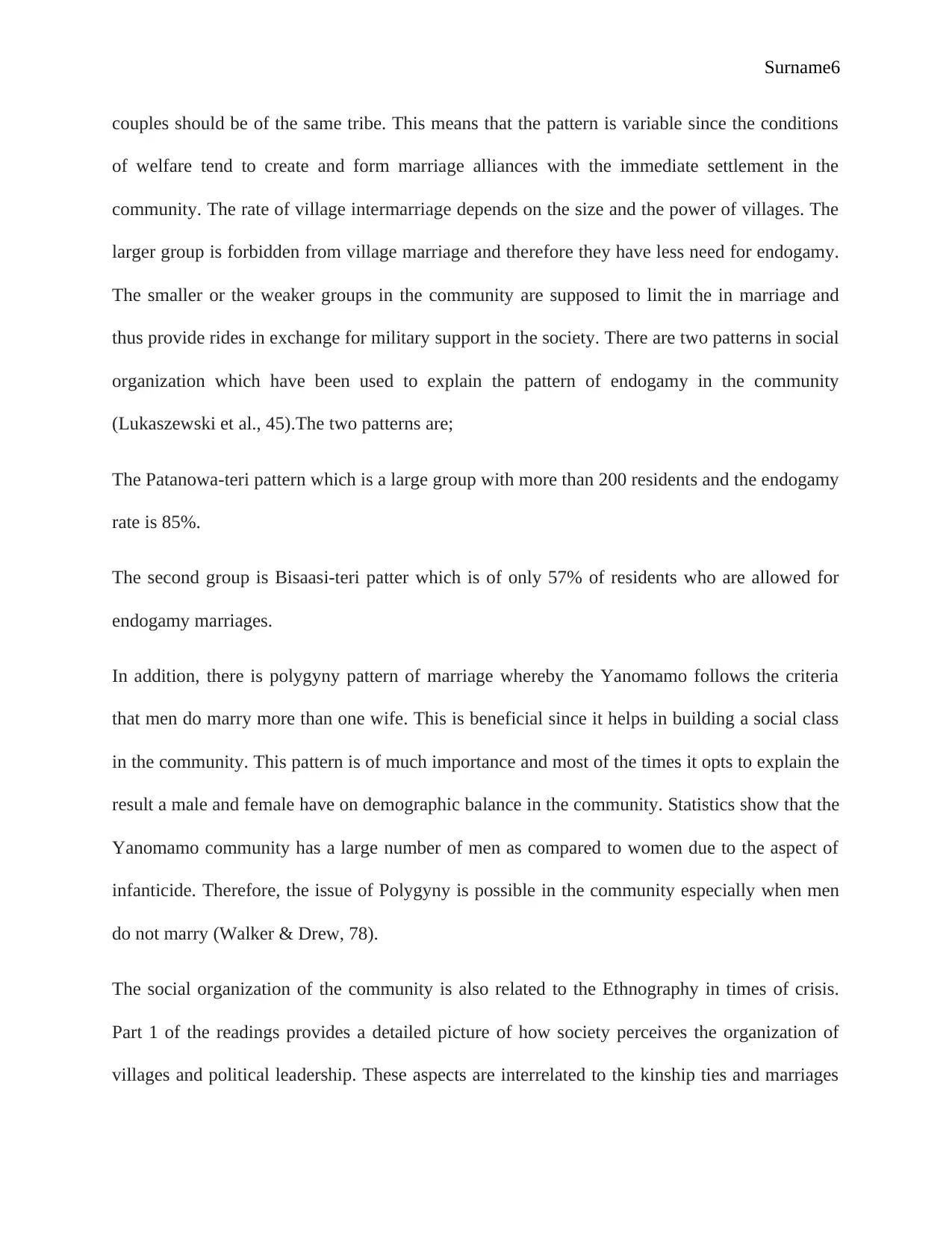
Surname6
couples should be of the same tribe. This means that the pattern is variable since the conditions
of welfare tend to create and form marriage alliances with the immediate settlement in the
community. The rate of village intermarriage depends on the size and the power of villages. The
larger group is forbidden from village marriage and therefore they have less need for endogamy.
The smaller or the weaker groups in the community are supposed to limit the in marriage and
thus provide rides in exchange for military support in the society. There are two patterns in social
organization which have been used to explain the pattern of endogamy in the community
(Lukaszewski et al., 45).The two patterns are;
The Patanowa-teri pattern which is a large group with more than 200 residents and the endogamy
rate is 85%.
The second group is Bisaasi-teri patter which is of only 57% of residents who are allowed for
endogamy marriages.
In addition, there is polygyny pattern of marriage whereby the Yanomamo follows the criteria
that men do marry more than one wife. This is beneficial since it helps in building a social class
in the community. This pattern is of much importance and most of the times it opts to explain the
result a male and female have on demographic balance in the community. Statistics show that the
Yanomamo community has a large number of men as compared to women due to the aspect of
infanticide. Therefore, the issue of Polygyny is possible in the community especially when men
do not marry (Walker & Drew, 78).
The social organization of the community is also related to the Ethnography in times of crisis.
Part 1 of the readings provides a detailed picture of how society perceives the organization of
villages and political leadership. These aspects are interrelated to the kinship ties and marriages
couples should be of the same tribe. This means that the pattern is variable since the conditions
of welfare tend to create and form marriage alliances with the immediate settlement in the
community. The rate of village intermarriage depends on the size and the power of villages. The
larger group is forbidden from village marriage and therefore they have less need for endogamy.
The smaller or the weaker groups in the community are supposed to limit the in marriage and
thus provide rides in exchange for military support in the society. There are two patterns in social
organization which have been used to explain the pattern of endogamy in the community
(Lukaszewski et al., 45).The two patterns are;
The Patanowa-teri pattern which is a large group with more than 200 residents and the endogamy
rate is 85%.
The second group is Bisaasi-teri patter which is of only 57% of residents who are allowed for
endogamy marriages.
In addition, there is polygyny pattern of marriage whereby the Yanomamo follows the criteria
that men do marry more than one wife. This is beneficial since it helps in building a social class
in the community. This pattern is of much importance and most of the times it opts to explain the
result a male and female have on demographic balance in the community. Statistics show that the
Yanomamo community has a large number of men as compared to women due to the aspect of
infanticide. Therefore, the issue of Polygyny is possible in the community especially when men
do not marry (Walker & Drew, 78).
The social organization of the community is also related to the Ethnography in times of crisis.
Part 1 of the readings provides a detailed picture of how society perceives the organization of
villages and political leadership. These aspects are interrelated to the kinship ties and marriages
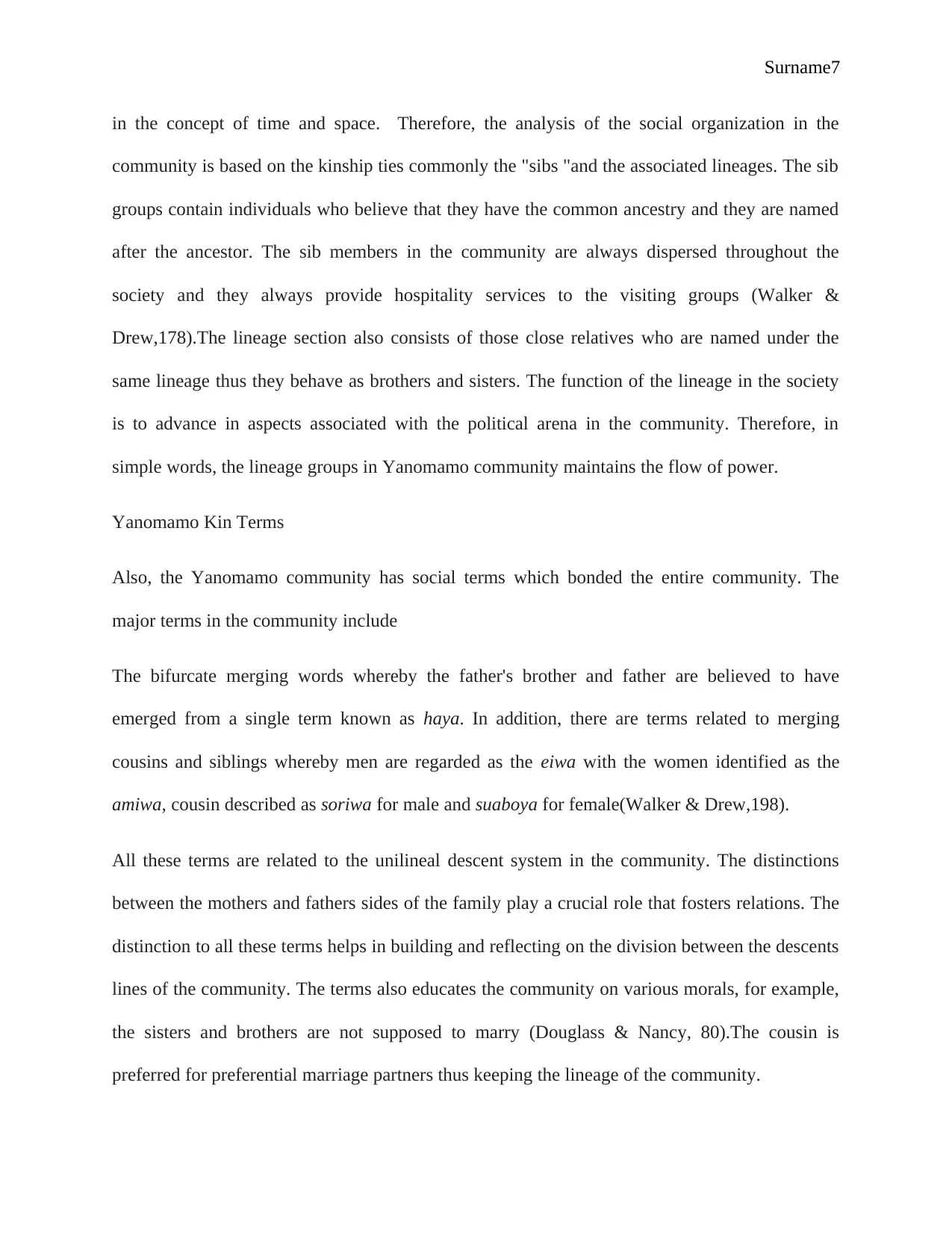
Surname7
in the concept of time and space. Therefore, the analysis of the social organization in the
community is based on the kinship ties commonly the "sibs "and the associated lineages. The sib
groups contain individuals who believe that they have the common ancestry and they are named
after the ancestor. The sib members in the community are always dispersed throughout the
society and they always provide hospitality services to the visiting groups (Walker &
Drew,178).The lineage section also consists of those close relatives who are named under the
same lineage thus they behave as brothers and sisters. The function of the lineage in the society
is to advance in aspects associated with the political arena in the community. Therefore, in
simple words, the lineage groups in Yanomamo community maintains the flow of power.
Yanomamo Kin Terms
Also, the Yanomamo community has social terms which bonded the entire community. The
major terms in the community include
The bifurcate merging words whereby the father's brother and father are believed to have
emerged from a single term known as haya. In addition, there are terms related to merging
cousins and siblings whereby men are regarded as the eiwa with the women identified as the
amiwa, cousin described as soriwa for male and suaboya for female(Walker & Drew,198).
All these terms are related to the unilineal descent system in the community. The distinctions
between the mothers and fathers sides of the family play a crucial role that fosters relations. The
distinction to all these terms helps in building and reflecting on the division between the descents
lines of the community. The terms also educates the community on various morals, for example,
the sisters and brothers are not supposed to marry (Douglass & Nancy, 80).The cousin is
preferred for preferential marriage partners thus keeping the lineage of the community.
in the concept of time and space. Therefore, the analysis of the social organization in the
community is based on the kinship ties commonly the "sibs "and the associated lineages. The sib
groups contain individuals who believe that they have the common ancestry and they are named
after the ancestor. The sib members in the community are always dispersed throughout the
society and they always provide hospitality services to the visiting groups (Walker &
Drew,178).The lineage section also consists of those close relatives who are named under the
same lineage thus they behave as brothers and sisters. The function of the lineage in the society
is to advance in aspects associated with the political arena in the community. Therefore, in
simple words, the lineage groups in Yanomamo community maintains the flow of power.
Yanomamo Kin Terms
Also, the Yanomamo community has social terms which bonded the entire community. The
major terms in the community include
The bifurcate merging words whereby the father's brother and father are believed to have
emerged from a single term known as haya. In addition, there are terms related to merging
cousins and siblings whereby men are regarded as the eiwa with the women identified as the
amiwa, cousin described as soriwa for male and suaboya for female(Walker & Drew,198).
All these terms are related to the unilineal descent system in the community. The distinctions
between the mothers and fathers sides of the family play a crucial role that fosters relations. The
distinction to all these terms helps in building and reflecting on the division between the descents
lines of the community. The terms also educates the community on various morals, for example,
the sisters and brothers are not supposed to marry (Douglass & Nancy, 80).The cousin is
preferred for preferential marriage partners thus keeping the lineage of the community.
Paraphrase This Document
Need a fresh take? Get an instant paraphrase of this document with our AI Paraphraser
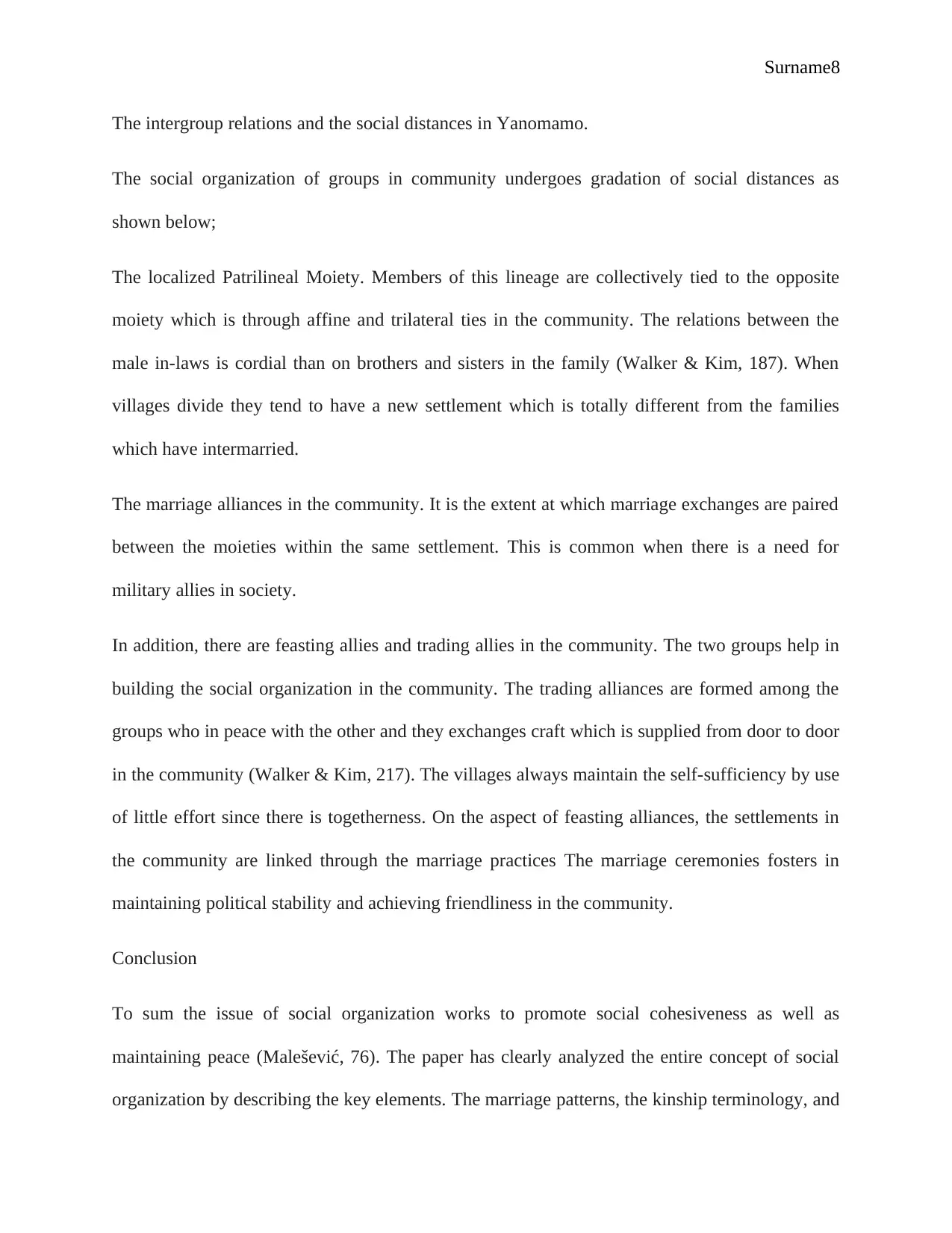
Surname8
The intergroup relations and the social distances in Yanomamo.
The social organization of groups in community undergoes gradation of social distances as
shown below;
The localized Patrilineal Moiety. Members of this lineage are collectively tied to the opposite
moiety which is through affine and trilateral ties in the community. The relations between the
male in-laws is cordial than on brothers and sisters in the family (Walker & Kim, 187). When
villages divide they tend to have a new settlement which is totally different from the families
which have intermarried.
The marriage alliances in the community. It is the extent at which marriage exchanges are paired
between the moieties within the same settlement. This is common when there is a need for
military allies in society.
In addition, there are feasting allies and trading allies in the community. The two groups help in
building the social organization in the community. The trading alliances are formed among the
groups who in peace with the other and they exchanges craft which is supplied from door to door
in the community (Walker & Kim, 217). The villages always maintain the self-sufficiency by use
of little effort since there is togetherness. On the aspect of feasting alliances, the settlements in
the community are linked through the marriage practices The marriage ceremonies fosters in
maintaining political stability and achieving friendliness in the community.
Conclusion
To sum the issue of social organization works to promote social cohesiveness as well as
maintaining peace (Malešević, 76). The paper has clearly analyzed the entire concept of social
organization by describing the key elements. The marriage patterns, the kinship terminology, and
The intergroup relations and the social distances in Yanomamo.
The social organization of groups in community undergoes gradation of social distances as
shown below;
The localized Patrilineal Moiety. Members of this lineage are collectively tied to the opposite
moiety which is through affine and trilateral ties in the community. The relations between the
male in-laws is cordial than on brothers and sisters in the family (Walker & Kim, 187). When
villages divide they tend to have a new settlement which is totally different from the families
which have intermarried.
The marriage alliances in the community. It is the extent at which marriage exchanges are paired
between the moieties within the same settlement. This is common when there is a need for
military allies in society.
In addition, there are feasting allies and trading allies in the community. The two groups help in
building the social organization in the community. The trading alliances are formed among the
groups who in peace with the other and they exchanges craft which is supplied from door to door
in the community (Walker & Kim, 217). The villages always maintain the self-sufficiency by use
of little effort since there is togetherness. On the aspect of feasting alliances, the settlements in
the community are linked through the marriage practices The marriage ceremonies fosters in
maintaining political stability and achieving friendliness in the community.
Conclusion
To sum the issue of social organization works to promote social cohesiveness as well as
maintaining peace (Malešević, 76). The paper has clearly analyzed the entire concept of social
organization by describing the key elements. The marriage patterns, the kinship terminology, and
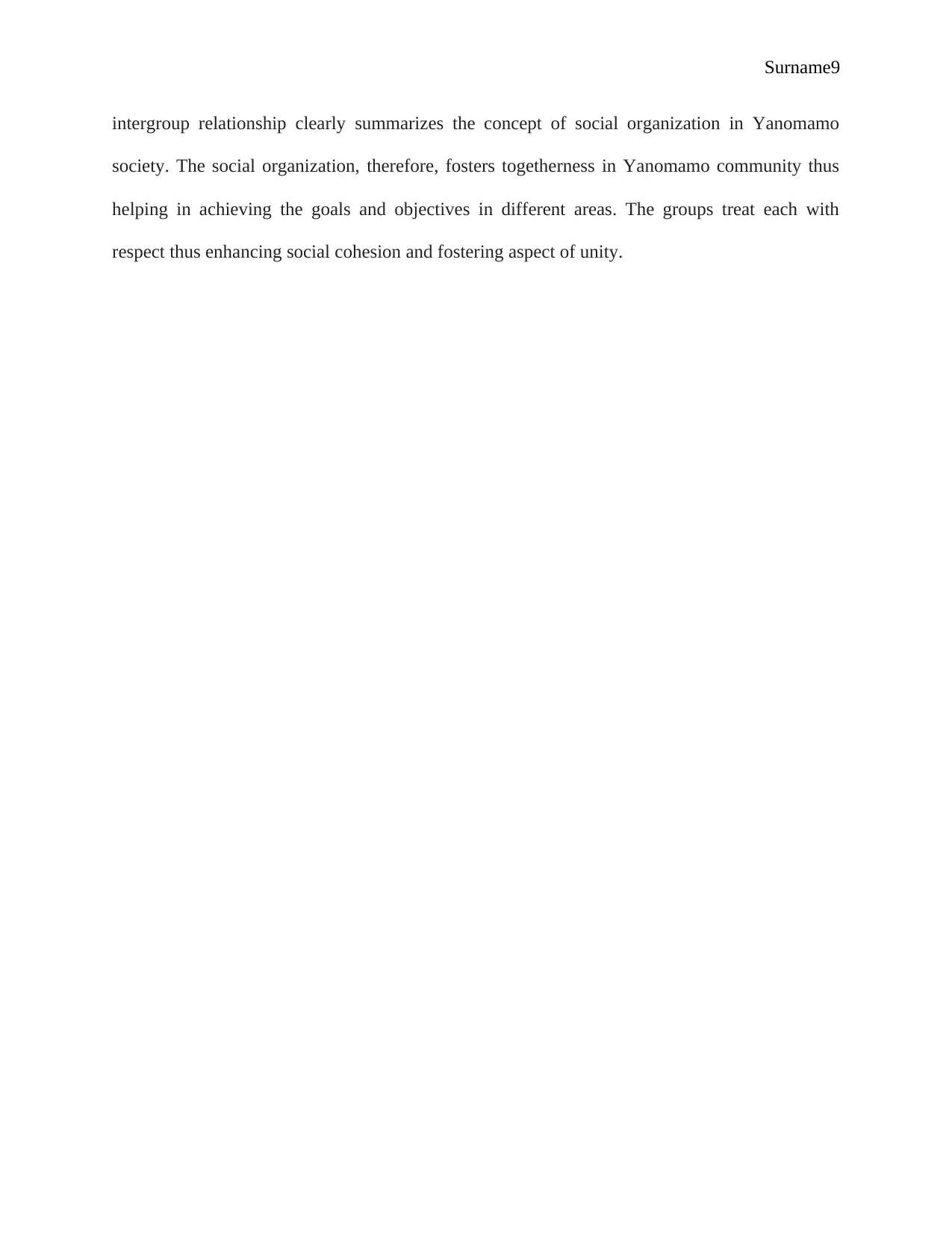
Surname9
intergroup relationship clearly summarizes the concept of social organization in Yanomamo
society. The social organization, therefore, fosters togetherness in Yanomamo community thus
helping in achieving the goals and objectives in different areas. The groups treat each with
respect thus enhancing social cohesion and fostering aspect of unity.
intergroup relationship clearly summarizes the concept of social organization in Yanomamo
society. The social organization, therefore, fosters togetherness in Yanomamo community thus
helping in achieving the goals and objectives in different areas. The groups treat each with
respect thus enhancing social cohesion and fostering aspect of unity.
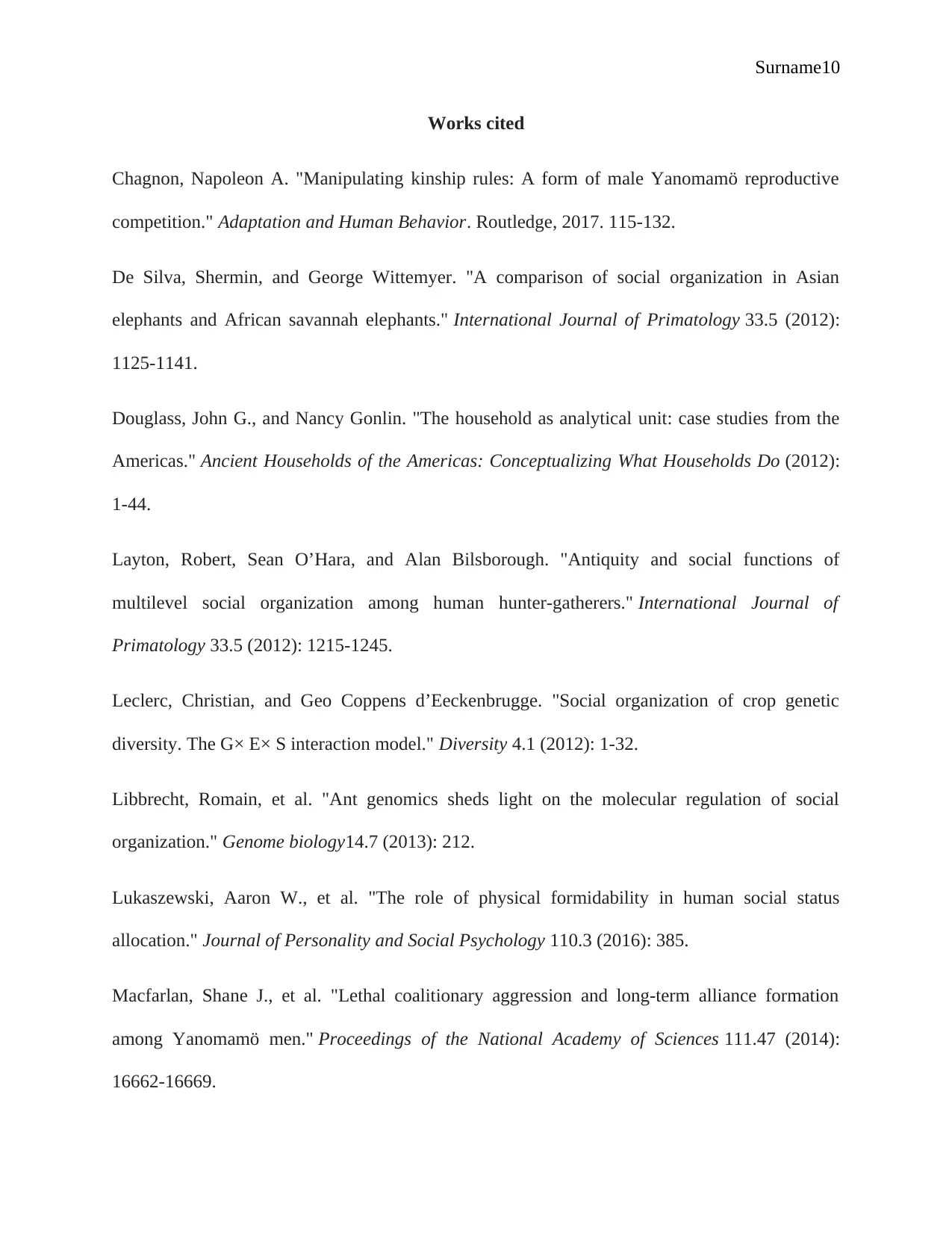
Surname10
Works cited
Chagnon, Napoleon A. "Manipulating kinship rules: A form of male Yanomamö reproductive
competition." Adaptation and Human Behavior. Routledge, 2017. 115-132.
De Silva, Shermin, and George Wittemyer. "A comparison of social organization in Asian
elephants and African savannah elephants." International Journal of Primatology 33.5 (2012):
1125-1141.
Douglass, John G., and Nancy Gonlin. "The household as analytical unit: case studies from the
Americas." Ancient Households of the Americas: Conceptualizing What Households Do (2012):
1-44.
Layton, Robert, Sean O’Hara, and Alan Bilsborough. "Antiquity and social functions of
multilevel social organization among human hunter-gatherers." International Journal of
Primatology 33.5 (2012): 1215-1245.
Leclerc, Christian, and Geo Coppens d’Eeckenbrugge. "Social organization of crop genetic
diversity. The G× E× S interaction model." Diversity 4.1 (2012): 1-32.
Libbrecht, Romain, et al. "Ant genomics sheds light on the molecular regulation of social
organization." Genome biology14.7 (2013): 212.
Lukaszewski, Aaron W., et al. "The role of physical formidability in human social status
allocation." Journal of Personality and Social Psychology 110.3 (2016): 385.
Macfarlan, Shane J., et al. "Lethal coalitionary aggression and long-term alliance formation
among Yanomamö men." Proceedings of the National Academy of Sciences 111.47 (2014):
16662-16669.
Works cited
Chagnon, Napoleon A. "Manipulating kinship rules: A form of male Yanomamö reproductive
competition." Adaptation and Human Behavior. Routledge, 2017. 115-132.
De Silva, Shermin, and George Wittemyer. "A comparison of social organization in Asian
elephants and African savannah elephants." International Journal of Primatology 33.5 (2012):
1125-1141.
Douglass, John G., and Nancy Gonlin. "The household as analytical unit: case studies from the
Americas." Ancient Households of the Americas: Conceptualizing What Households Do (2012):
1-44.
Layton, Robert, Sean O’Hara, and Alan Bilsborough. "Antiquity and social functions of
multilevel social organization among human hunter-gatherers." International Journal of
Primatology 33.5 (2012): 1215-1245.
Leclerc, Christian, and Geo Coppens d’Eeckenbrugge. "Social organization of crop genetic
diversity. The G× E× S interaction model." Diversity 4.1 (2012): 1-32.
Libbrecht, Romain, et al. "Ant genomics sheds light on the molecular regulation of social
organization." Genome biology14.7 (2013): 212.
Lukaszewski, Aaron W., et al. "The role of physical formidability in human social status
allocation." Journal of Personality and Social Psychology 110.3 (2016): 385.
Macfarlan, Shane J., et al. "Lethal coalitionary aggression and long-term alliance formation
among Yanomamö men." Proceedings of the National Academy of Sciences 111.47 (2014):
16662-16669.
Secure Best Marks with AI Grader
Need help grading? Try our AI Grader for instant feedback on your assignments.
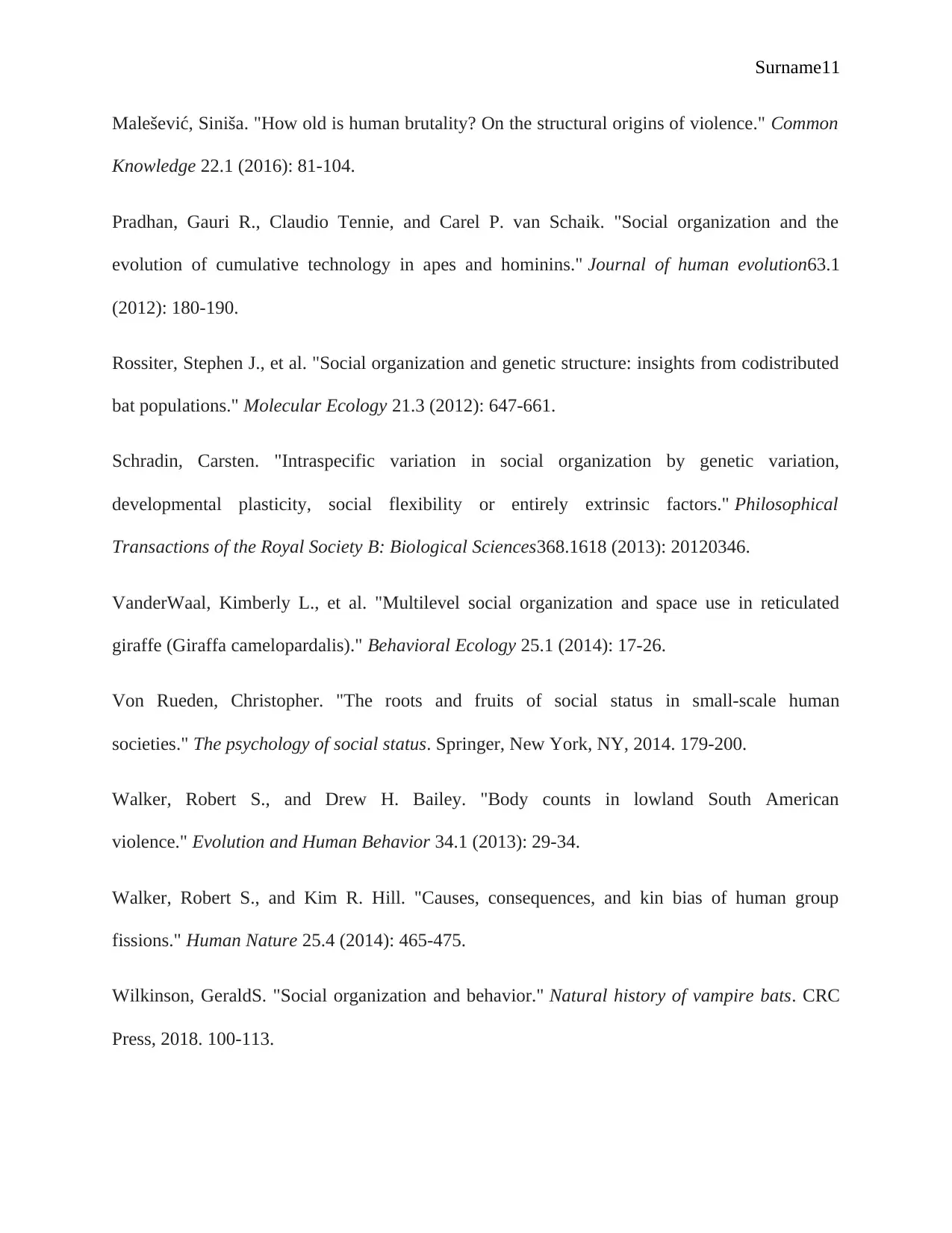
Surname11
Malešević, Siniša. "How old is human brutality? On the structural origins of violence." Common
Knowledge 22.1 (2016): 81-104.
Pradhan, Gauri R., Claudio Tennie, and Carel P. van Schaik. "Social organization and the
evolution of cumulative technology in apes and hominins." Journal of human evolution63.1
(2012): 180-190.
Rossiter, Stephen J., et al. "Social organization and genetic structure: insights from codistributed
bat populations." Molecular Ecology 21.3 (2012): 647-661.
Schradin, Carsten. "Intraspecific variation in social organization by genetic variation,
developmental plasticity, social flexibility or entirely extrinsic factors." Philosophical
Transactions of the Royal Society B: Biological Sciences368.1618 (2013): 20120346.
VanderWaal, Kimberly L., et al. "Multilevel social organization and space use in reticulated
giraffe (Giraffa camelopardalis)." Behavioral Ecology 25.1 (2014): 17-26.
Von Rueden, Christopher. "The roots and fruits of social status in small-scale human
societies." The psychology of social status. Springer, New York, NY, 2014. 179-200.
Walker, Robert S., and Drew H. Bailey. "Body counts in lowland South American
violence." Evolution and Human Behavior 34.1 (2013): 29-34.
Walker, Robert S., and Kim R. Hill. "Causes, consequences, and kin bias of human group
fissions." Human Nature 25.4 (2014): 465-475.
Wilkinson, GeraldS. "Social organization and behavior." Natural history of vampire bats. CRC
Press, 2018. 100-113.
Malešević, Siniša. "How old is human brutality? On the structural origins of violence." Common
Knowledge 22.1 (2016): 81-104.
Pradhan, Gauri R., Claudio Tennie, and Carel P. van Schaik. "Social organization and the
evolution of cumulative technology in apes and hominins." Journal of human evolution63.1
(2012): 180-190.
Rossiter, Stephen J., et al. "Social organization and genetic structure: insights from codistributed
bat populations." Molecular Ecology 21.3 (2012): 647-661.
Schradin, Carsten. "Intraspecific variation in social organization by genetic variation,
developmental plasticity, social flexibility or entirely extrinsic factors." Philosophical
Transactions of the Royal Society B: Biological Sciences368.1618 (2013): 20120346.
VanderWaal, Kimberly L., et al. "Multilevel social organization and space use in reticulated
giraffe (Giraffa camelopardalis)." Behavioral Ecology 25.1 (2014): 17-26.
Von Rueden, Christopher. "The roots and fruits of social status in small-scale human
societies." The psychology of social status. Springer, New York, NY, 2014. 179-200.
Walker, Robert S., and Drew H. Bailey. "Body counts in lowland South American
violence." Evolution and Human Behavior 34.1 (2013): 29-34.
Walker, Robert S., and Kim R. Hill. "Causes, consequences, and kin bias of human group
fissions." Human Nature 25.4 (2014): 465-475.
Wilkinson, GeraldS. "Social organization and behavior." Natural history of vampire bats. CRC
Press, 2018. 100-113.
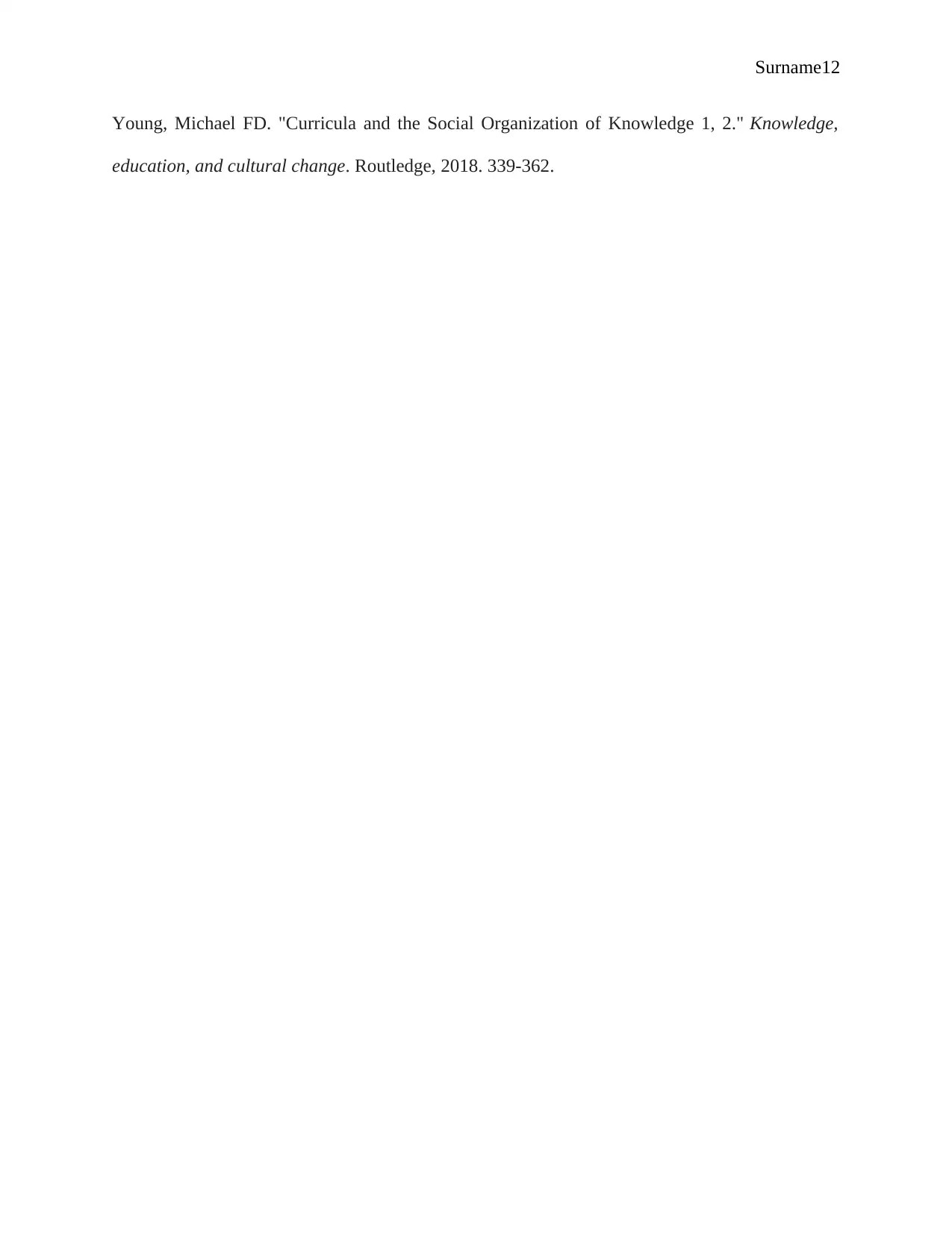
Surname12
Young, Michael FD. "Curricula and the Social Organization of Knowledge 1, 2." Knowledge,
education, and cultural change. Routledge, 2018. 339-362.
Young, Michael FD. "Curricula and the Social Organization of Knowledge 1, 2." Knowledge,
education, and cultural change. Routledge, 2018. 339-362.
1 out of 12
Related Documents
Your All-in-One AI-Powered Toolkit for Academic Success.
+13062052269
info@desklib.com
Available 24*7 on WhatsApp / Email
![[object Object]](/_next/static/media/star-bottom.7253800d.svg)
Unlock your academic potential
© 2024 | Zucol Services PVT LTD | All rights reserved.





